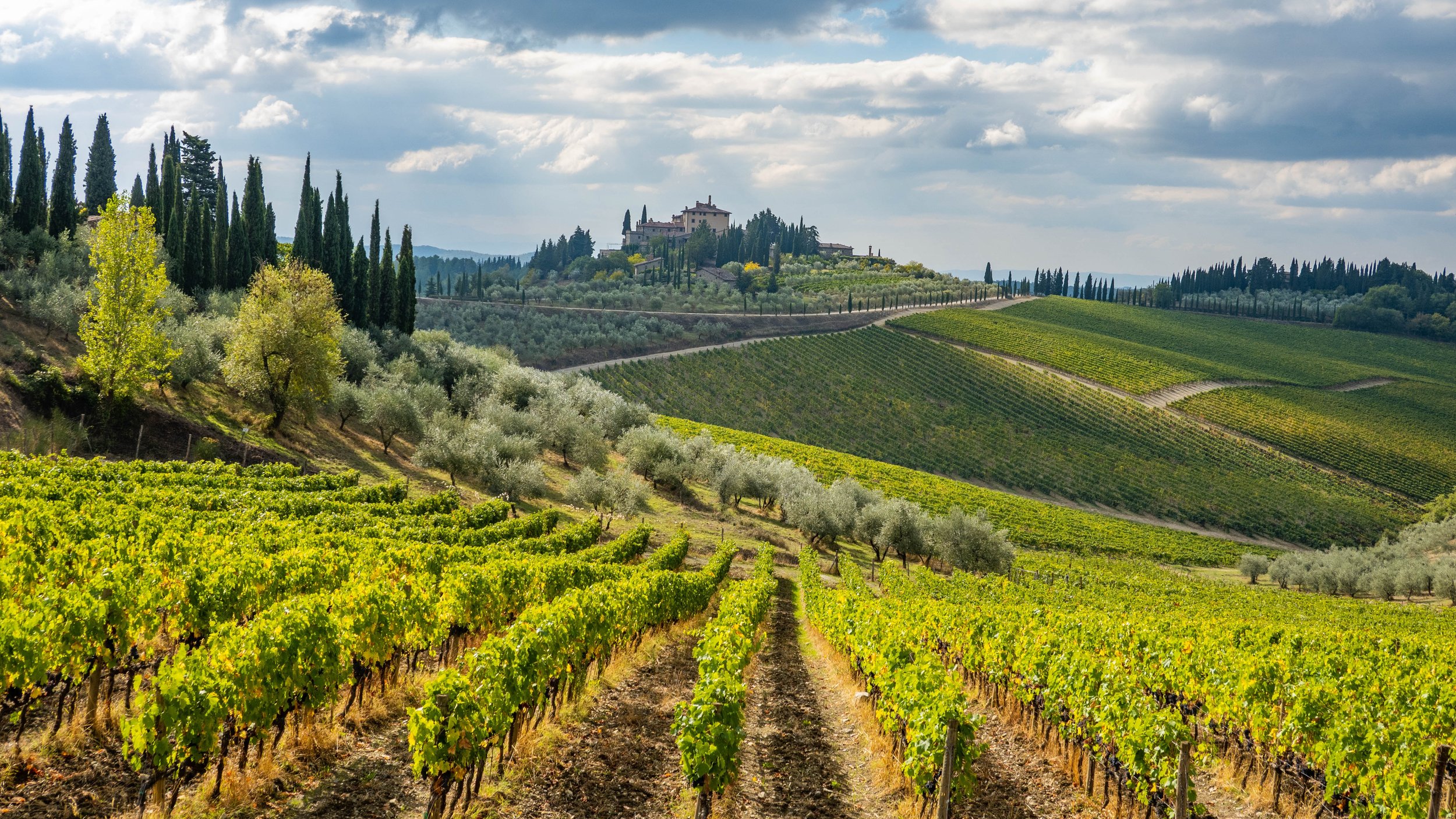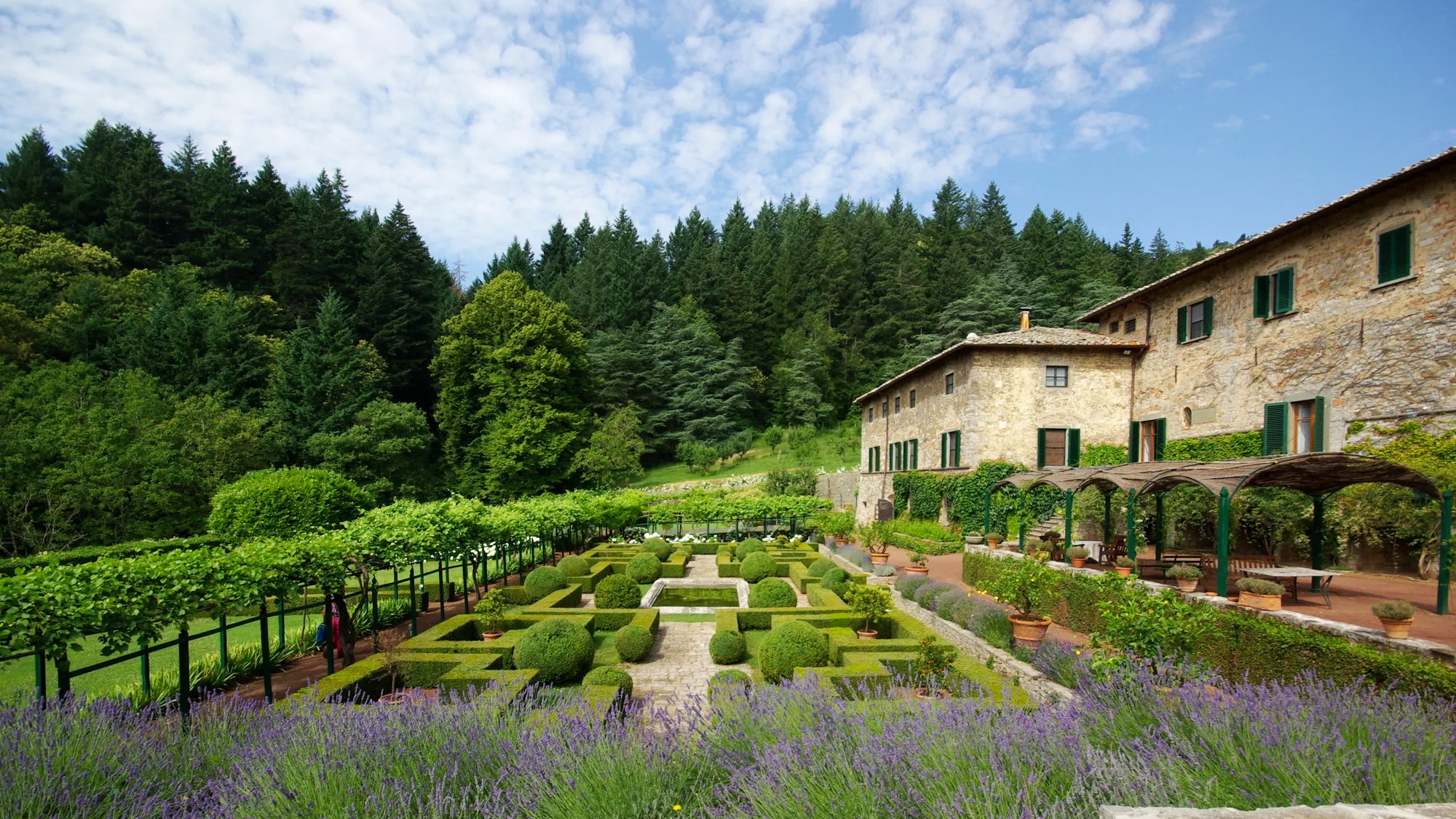Highlights of Chianti
Castles, Abbeys, Hill Towns & Wineries
On the magnificent ceiling of the Hall of the Five Hundred in Florence’s Palazzo Vecchio is a panel-painting of Chianti by the great Renaissance artist-architect Giorgio Vasari, dating from 1547. Vasari accompanied his work with an evocative description of it written for his patron, Cosimo I de’Medici:
This, Sir, is Chianti, with the rivers of the Pesa and the Elsa, with its cornucopias of fruit, and at their feet a mature Bacchus to represent the excellent wines of this landscape.
So Vasari encapsulates the essence of Chianti – a place that for centuries has been associated with heady wines, fertile abundance and natural beauty.
The ‘sweet hills’ of Chianti stretch between Florence and Siena covering an area of around 260 square kilometres. Two-thirds of Chianti are cloaked in woodlands of ever-green holm oaks, chestnuts, pines and silver firs – ‘woods as deep as love’, wrote Dylan Thomas. The remaining land is planted with olive groves and vines that produce the area’s exceptional oils and wines.
The hills are criss-crossed by ‘strade bianche’ – dusty tracks (literally, ‘white roads’) that thread quietly through voluptuous scenery. They have never been asphalted in order to preserve the natural ecosystem here and to encourage slow travel through Chianti’s ravishing scenery, where you can discover its historic towns, medieval hill-villages, romantic castles and fortified borghi.
Castellina in Chianti
Along with Greve and Radda, Castellina is one of Chianti’s three principal towns and here one can most easily trace the story of its first known settlements. The word ‘Chianti’ probably derives from the ancient Etruscan word ‘Clante’ and, throughout these storied hills, many historic places have redolent names of Etruscan origin: Spaltenna, Avenano, Ama, Nusenna, Rosennano, the rivers of the Ambra, Arbia, Elsa and Pesa.
Necropolises and archaeological remains have been unearthed in and around Castellina, bearing witness to an aristocratic Etruscan civilization here from at least the 7th century BCE. The hauntingly atmospheric Etruscan burial mound of Montecalvario, just outside Castellina, is the best-preserved tomb, while the five tombs of Poggino have a wild beauty - buried in woodland, overgrown with nature. Many of the local archaeological finds – including a fine Etruscan carriage - are on display in the little museum in the medieval tower of Castellina’s fortress, the Rocca.
Quite apart from its Etruscan history, Castellina is a delightful town to explore, with its vaulted and stone-paved streets (pictured above), its medieval houses and Renaissance palazzi, and the 15th-century fortress which commands panoramic views.
Badia a Coltibuono
One of the earliest documents that refers to Chianti as a geographical area is a 12th-century manuscript from this monastery. Founded in 1051, the ‘Abbey of Good Harvest’ rises high in the hills above Gaiole in Chianti - a place of silent beauty, with seraphic views across the valley of the River Arno.
Its name (from the Latin, ‘Cultus Boni’ – ‘Good Harvest’) suggests the fertile lands of this area, long used for cultivating vines and wheat, olives and chestnuts. Recent archaeological digs at Cetamura, within Coltibuono’s estate, have unearthed Etruscan grape pips and vessels testifying to over 2000 years of wine-making here. Later, the Vallombrosian monks who settled at Coltibuono in the 12th century cultivated a long tradition of agriculture, planting woods of white fir and chestnut, producing wine, wheat and olive oil – traditions that continue today.
Not long after the suppression of the abbey in 1810, the entire property was bought by Michele Giuntini whose descendants still own it, maintaining its ethos and spirit, six generations on. The former monks’ refectory, adorned with Renaissance frescoes, is now a grand vaulted lounge and the ancient wine cellars (pictured below) which sprawl under the abbey into the old crypt of the church are still in use, fragrant with the aromas of oak barrels and grape must.
The monastic gardens maintain the layout of a ‘hortus conclusus’ – an enclosed garden traditionally planted with geometric box hedges, medicinal herbs and flowers. Around the parterres are vine-clad pergolas and ponds edged with fountains of banksia roses and sprays of white hydrangeas.
Badia a Passignano
At the heart of this enchanting Chianti village is another historic abbey: the Badia a Passignano, whose origins go back to the late 9th century and which still functions as a monastery today. Girdled with a thick wall of cypress trees, it seems to have stepped out of the pages of a storybook.
The abbey is dedicated to St Michael the Archangel, around whom a cult grew up in medieval Chianti. It is one of a number of sacred sites - churches, chapels, springs, celestial hills - scattered across Chianti dedicated to the archangel. They formed the focal points of medieval pilgrimages from Florence to Siena, or to the highest point in the Chianti hills: Monte San Michele.
The abbey’s refectory is frescoed with a beautiful Last Supper (pictured below) painted in 1476 by the leading fresco artist of the time: Domenico Ghirlandaio (in whose workshop the young Michelangelo was an apprentice). It’s tempting to think that the carafes which stand on Ghirlandaio’s great monastic table have been filled with wine from the abbey’s ancient cellars.
Those cellars are still in use to this day, run by the Antinori family whose vineyards swathe the surrounding land. For centuries, Passignano’s hill-slopes have been planted with Sangiovese vines: a thousand-year-old vine was discovered on the land just recently.
Montefioralle
The little borgo of Montefioralle circles the hillside above the pretty market town of Greve, immersed in classic Chianti countryside: bosky hills, vineyards and olive groves. It lies on a ridge that connects the valleys of the Elsa, Pesa and Greve rivers with the Upper Val d’Arno; its strategic position explains its origins as a fortress, originally known as Monteficalli: the ‘Hill of Fig Trees’.
Despite its compact size, Monteficalli was one of the most important military centres in this area from the 11th century and its buildings were later owned by some important Tuscan families: the Ricasoli, aristocratic land owners and wine makers; the Benci and Gherardini families, both of whom commissioned portraits from Leonardo da Vinci; and the descendants of the explorer Giovanni Vespucci whose house still bears the Vespucci family crest.
The atmosphere of a medieval fortification still lingers in the elliptical-shaped hamlet with its golden stone walls, gateways, and watchtowers now lowered in height and turned into picturesque houses.
Volpaia
Rising on a panoramic ridge above the Pesa river, the remarkably well-preserved walled ‘castello’ of Volpaia is one of the jewels of the area. Like most of Chianti’s hill-top settlements, it grew up around the 1st millennium as a defensive, towered castle on the contentious boundary between the territories of Florence and Siena.
In the later Middle Ages, Volpaia became a rest-point for pilgrims heading to Siena and Rome: at the heart of the ‘castello’ is the hospice of the Knights of Malta which, from the early 1400s, offered board and lodging for the weary pilgrim-traveller. The importance of devotion in this celestial place is also suggested by its many churches, chapels and oratories; particularly enchanting is the lonely woodland sanctuary of the Madonna del Fossato, built to protect a Renaissance image of the Virgin Mary, believed to be miraculous.
Vines have been cultivated on the hill-slopes here since the 12th century, and Volpaia’s organic Chianti Classico – aged in musty cellars under the castle and church – has been lauded by Wine Spectator as one of the three best wines in the world.
When the 17th-century polymath Francesco Redi wrote his eulogy on Tuscan wines – ‘Bacchus in Tuscany’ – in 1685, he described Chianti as ‘aged, majestic and proud’ - words that also distil the essence of this rapturous landscape.
TOUR FLORENCE & TUSCANY
IN MAY 2024
Join cultural historian and Florence resident Kate Bolton-Porciatti on this 16-day journey through the storied hills of Tuscany, taking us from Florence through Chianti to Siena, San Gimignano, Pisa and Lucca as we trace the origins of the cities and hill towns of the region and explore their artistic, musical and cultural legacy.











